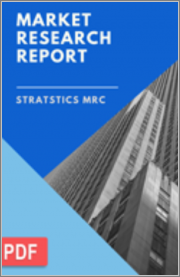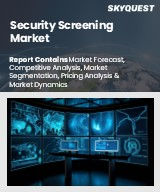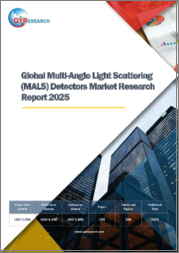
|
시장보고서
상품코드
1383439
엔드포인트 디텍터 시장 예측(-2030년) : 유형별, 용도별, 지역별 세계 분석End Point Detector Market Forecasts to 2030 - Global Analysis By Type, By Application and By Geography |
||||||
Stratistics MRC에 따르면, 세계 엔드포인트 디텍터 시장은 예측 기간 동안 CAGR 12.5%로 성장할 것입니다.
엔드포인트 디텍터는 크로마토그래피 및 적정 시스템과 같은 분석 장비 및 과학 기기에 사용되는 장비 및 소프트웨어 기능으로, 반응 또는 분석이 종점에 도달한 정확한 시점을 식별하는 장치 및 소프트웨어 기능입니다. 정확한 측정과 공정의 정밀한 제어를 위해 필수적이며 원하는 결과를 얻을 수 있도록 보장합니다.
미국화학 산업협회(American Chemistry Council, Inc.)에 따르면, 화학사업은 연간 약 5,170억 달러를 창출하며 미국 GDP의 약 25%를 차지합니다.
실시간 모니터링에 대한 수요 증가
제약, 환경 모니터링, 화학 분석 등 다양한 산업 분야에서 신속한 의사 결정과 품질 관리를 위해 즉각적이고 지속적인 데이터가 필요합니다. 실시간 종점 감지 시스템은 변화하는 상황에 신속하게 대응하고 제품 품질, 공정 효율성 및 규제 표준 준수를 보장합니다. 이러한 수요는 프로세스를 최적화하고 인적 오류를 줄이며 전반적인 생산성을 향상시켜야 할 필요성에 의해 촉진되고 있습니다. 그 결과, 실시간 기능을 제공하는 엔드포인트 감지기가 증가하면서 시장 성장을 더욱 촉진하고 있습니다.
획득비용이 크다
이러한 고급 탐지 시스템에는 많은 초기 투자가 필요한 경우가 많으며, 이는 중소기업, 연구소, 예산이 한정된 조직에게는 진입 장벽이 될 수 있습니다. 막대한 비용에는 엔드포인트 탐지 장비 구매뿐만 아니라 설치, 교육 및 지속적인 유지보수 비용도 포함됩니다. 이러한 경제적 부담은 고급 엔드포인트 탐지기의 채택을 방해하고, 자금력이 있는 기관과 기업의 제한된 범위에서만 사용할 수 있습니다.
성장하는 연구 활동
바이오테크놀러지, 제약, 환경 과학 등의 분야에서 연구 활동이 확대됨에 따라 정밀하고 신뢰할 수 있는 엔드포인트 검출 시스템에 대한 수요가 증가하고 있습니다. 연구자들은 정보에 입각한 의사결정을 내리고, 제품 품질을 보장하며, 규제 요건을 충족하기 위해 정확한 데이터를 필요로 합니다. 이러한 추세는 엔드포인트 디텍터 제조업체들이 특정 연구 요구에 맞는 고도의 적응성, 적응성, 효율성을 갖춘 솔루션을 제공할 수 있는 기회를 제공합니다. 혁신과 커스터마이징에 중점을 두면 기업은 이 기회를 활용해 다양한 연구 용도에 대응할 수 있습니다.
경기침체 또는 불확실성
경기 침체기에는 기업들이 엔드포인트 디텍터와 같은 분석 장비에 대한 투자를 포함하여 설비 투자를 줄이는 경우가 많으며, 이로 인해 시장 수요가 감소할 수 있습니다. 금융 시장의 불확실성 또한 프로젝트 연기 및 중단으로 이어져 조직의 구매 결정에 영향을 미칠 수 있습니다. 또한, 이러한 어려운 경제 상황에서는 R&D 예산이 억제되어 기술 혁신과 첨단 엔드포인트 탐지 기술 개발을 방해할 수 있습니다.
COVID-19의 영향:
COVID-19 팬데믹은 엔드포인트 디텍터 시장에 긍정적인 영향과 부정적인 영향을 모두 미쳤습니다. 공급망과 제조의 혼란, 실험실 접근 제한 등으로 인해 일시적으로 시장 성장이 둔화됐지만, 팬데믹 기간 동안 헬스케어와 진단에 대한 관심이 높아지면서 COVID-19 검사와 같은 용도로 엔드포인트 디텍터 수요가 급증했습니다. 신속하고 정확한 엔드포인트 판정의 필요성이 진단 프로세스에서 가장 중요한 요소로 떠오르면서 시장에 비지니스 기회를 창출했습니다. 전반적으로, 팬데믹은 의료 및 제약 분야에서 엔드포인트 검출의 중요성을 강조했으며, 상황이 진행됨에 따라 시장은 변화하는 산업 역학에 계속 적응할 것으로 예상됩니다.
예측 기간 동안 전기화학 엔드포인트 디텍터가 가장 큰 비중을 차지할 것으로 예상
전기화학 엔드포인트 디텍터 부문은 효율성과 환경적 이점으로 인해 유리한 성장세를 보일 것으로 예상됩니다. 이 감지기는 전류 및 전위와 같은 전기 신호의 변화를 모니터링하여 화학 반응의 정확한 종점을 식별합니다. 일반적으로 산화 환원 적정 및 기타 전기 화학 공정에서 반응물이 완전히 반응한 정확한 시점을 확인하기 위해 사용됩니다. 전기화학 엔드포인트 디텍터는 매우 정확하고 정밀한 결과를 제공하기 때문에 의약품, 환경 모니터링, 품질 관리와 같이 신뢰할 수 있는 종점 결정의 필요성이 제품 품질과 산업 표준 준수를 보장하는 데 중요한 산업에서 필수적인 요소가 되었습니다.
제약 산업 부문은 예측 기간 동안 가장 높은 CAGR을 기록할 것으로 예상
제약 산업 부문은 예측 기간 동안 가장 빠른 CAGR 성장을 보일 것으로 예상됩니다. 엔드포인트 디텍터는 화학 반응의 종점을 결정하고 약물의 정확한 투여 및 처방을 보장하기 위해 제약 연구 및 품질 관리에 널리 사용됩니다. 엔드포인트 디텍터는 의약품 활성 성분의 합성 모니터링부터 제조 시 품질 보증, 규제 준수 지원, 일관된 제품 품질 유지에 이르기까지 의약품 개발에서 매우 중요한 역할을 합니다. 제약 공정에서 엔드포인트 검출의 정확성과 신뢰성은 환자 안전과 엄격한 산업 표준 준수를 위해 필수적이며, 이 분야에서 필수적인 도구가 되고 있습니다.
가장 높은 점유율을 보이는 지역:
예측 기간 동안 북미 시장이 시장 점유율의 대부분을 차지할 것으로 예상됩니다. 이 지역은 제약 및 바이오테크놀러지 부문이 잘 발달되어 있어 품질 관리 및 연구를 위해 정밀한 엔드포인트 검출 시스템을 필요로 하고 있습니다. 또한, 엄격한 환경 규제와 식품 및 음료 산업의 제품 품질에 대한 중요성이 분석 목적의 엔드포인트 디텍터 채택을 촉진하고 있습니다. 시장을 선도하는 기업들의 존재와 지속적인 연구개발 노력도 시장 성장에 기여하고 있습니다. 북미 지역에서는 자동화와 효율성이 강조되고 있습니다.
CAGR이 가장 높은 지역:
아시아태평양은 산업 기반이 확대되고 R&D 활동에 대한 중요성이 높아지면서 시장이 빠르게 성장하고 있습니다. 중국과 인도와 같은 국가의 제약 및 바이오테크놀러지 부문은 괄목할 만한 성장을 보이고 있으며, 이는 의약품 개발 및 품질 관리에서 정밀한 엔드포인트 검출 시스템에 대한 큰 수요를 창출하고 있습니다. 또한, 이 지역에서 빠르게 성장하고 있는 화학 및 석유화학 산업은 공정 최적화를 위해 신뢰할 수 있는 엔드포인트 디텍터를 필요로 합니다. 환경 문제에 대한 인식이 높아지고 규제가 강화됨에 따라 정확한 엔드포인트 판단의 필요성이 시장을 더욱 활성화시키고 있습니다.
무료 맞춤형 서비스
이 보고서를 구독하는 고객은 다음과 같은 무료 맞춤형 옵션 중 하나를 사용할 수 있습니다:
- 회사 프로필
- 추가 시장 기업의 종합적인 프로파일링(최대 3개사까지)
- 주요 기업 SWOT 분석(3개사까지)
- 지역 세분화
- 고객의 관심에 따른 주요 국가별 시장 추정 및 예측, CAGR(참고: 타당성 검토에 따른)
- 경쟁사 벤치마킹
- 제품 포트폴리오, 지리적 입지, 전략적 제휴를 기반으로 한 주요 기업 벤치마킹
목차
제1장 주요 요약
제2장 서문
- 개요
- 이해관계자
- 조사 범위
- 조사 방법
- 데이터 마이닝
- 데이터 분석
- 데이터 검증
- 조사 접근법
- 조사 소스
- 1차 조사 소스
- 2차 조사 소스
- 가정
제3장 시장 동향 분석
- 성장 촉진요인
- 성장 억제요인
- 기회
- 위협
- 용도 분석
- 신흥 시장
- 신종 코로나바이러스 감염증(COVID-19)의 영향
제4장 Porter's Five Forces 분석
- 공급 기업의 교섭력
- 구매자의 교섭력
- 대체품의 위협
- 신규 참여업체의 위협
- 경쟁 기업 간의 경쟁 관계
제5장 세계의 엔드포인트 디텍터 시장 : 유형별
- pH 엔드포인트 디텍터
- 전도율 엔드포인트 디텍터
- 전위차 측정 엔드포인트 디텍터
- 비색 엔드포인트 디텍터
- 중량 엔드포인트 디텍터
- 전기화학 엔드포인트 디텍터
- 기타 유형
제6장 세계의 엔드포인트 디텍터 시장 : 용도별
- 제약 산업
- 환경 분석
- 음식 업계
- 수처리
- 임상 진단
- 석유화학 산업
- 기타 용도
제7장 세계의 엔드포인트 디텍터 시장 : 지역별
- 북미
- 미국
- 캐나다
- 멕시코
- 유럽
- 독일
- 영국
- 이탈리아
- 프랑스
- 스페인
- 기타 유럽
- 아시아태평양
- 일본
- 중국
- 인도
- 호주
- 뉴질랜드
- 한국
- 기타 아시아태평양
- 남미
- 아르헨티나
- 브라질
- 칠레
- 기타 남미
- 중동 및 아프리카
- 사우디아라비아
- 아랍에미리트
- 카타르
- 남아프리카공화국
- 기타 중동 및 아프리카
제8장 주요 발전
- 계약, 파트너십, 협업, 합작투자
- 인수와 합병
- 신제품 발매
- 사업 확대
- 기타 주요 전략
제9장 기업 개요
- Agilent Technologies, Inc.
- Analytik Jena AG
- Bio-Rad Laboratories, Inc.
- Bruker Corporation
- Metrohm AG
- Mettler-Toledo International Inc.
- PerkinElmer, Inc.
- Radiometer Analytical
- Sartorius AG
- Shimadzu Corporation
- Thermo Fisher Scientific Inc.
According to Stratistics MRC, the Global End Point Detector Market is growing at a CAGR of 12.5% during the forecast period. An endpoint detector is a device or software feature used in analytical and scientific instruments, such as chromatography or titration systems, to identify the exact point at which a reaction or analysis has reached its endpoint. It is essential for accurate measurements and precise control of processes, ensuring that the desired outcome is achieved.
According to the American Chemistry Council, Inc., around US$ 517 billion is generated annually by the business of chemistry, and it contributes around 25% to the U.S GDP.
Market Dynamics:
Driver:
Growing demand for real-time monitoring
Industries across various sectors, including pharmaceuticals, environmental monitoring, and chemical analysis, require immediate and continuous data to make prompt decisions and maintain quality control. Real-time endpoint detection systems enable swift response to changing conditions, ensuring product quality, process efficiency, and compliance with regulatory standards. This demand is fueled by the need to optimize processes, reduce human error, and improve overall productivity. As a result, endpoint detectors that offer real-time capabilities are increasing, further propelling market growth.
Restraint:
The acquisition cost is substantial
These sophisticated detection systems often require a significant initial investment, which can be a barrier to entry for smaller businesses, research laboratories, or organizations with limited budgets. The substantial cost includes not only the purchase of the endpoint detection equipment but also installation, training, and ongoing maintenance expenses. This financial burden can hinder the adoption of advanced endpoint detectors, limiting their accessibility to a narrower range of well-funded institutions or enterprises.
Opportunity:
Growing research activities
As research endeavors expand in fields like biotechnology, pharmaceuticals, and environmental science, there is an increased demand for precise and reliable endpoint detection systems. Researchers require accurate data to make informed decisions, ensure product quality, and meet regulatory requirements. This trend opens doors for endpoint detector manufacturers to provide advanced, adaptable, and efficient solutions tailored to specific research needs. With an emphasis on innovation and customization, companies can tap into this opportunity to serve diverse research applications.
Threat:
Economic downturns or uncertainties
During economic downturns, companies often reduce capital expenditures, including investments in analytical instruments like endpoint detectors, which can result in a decline in market demand. Uncertainties in financial markets can also lead to postponed or canceled projects, impacting the purchasing decisions of organizations. Furthermore, in such challenging economic conditions, research and development budgets may be constrained, hindering innovation and the development of advanced endpoint detection technologies.
COVID-19 Impact:
The COVID-19 pandemic had both positive and negative impacts on the endpoint detector market. While disruptions in supply chains and manufacturing, as well as restricted laboratory access, temporarily slowed down market growth, the increased focus on healthcare and diagnostics during the pandemic led to a surge in demand for endpoint detectors in applications like COVID-19 testing. The need for quick and accurate endpoint determination became paramount in diagnostic processes, creating opportunities for the market. Overall, the pandemic emphasized the importance of endpoint detection in healthcare and pharmaceuticals, and as the situation evolves, the market is expected to continue adapting to changing industry dynamics.
The electrochemical endpoint detectors is expected to be the largest during the forecast period
The electrochemical endpoint detectors segment is expected to have a lucrative growth due to its efficiency and environmental benefits. These detectors monitor changes in electrical signals, such as current or potential, to identify the precise endpoint of a chemical reaction. They are commonly used in redox titrations and other electrochemical processes to determine the exact point at which the reactants have completely reacted. Electrochemical endpoint detectors provide highly accurate and precise results, making them essential in industries like pharmaceuticals, environmental monitoring, and quality control, where the need for reliable endpoint determination is critical for ensuring product quality and compliance with industry standards.
The pharmaceutical industry segment is expected to have the highest CAGR during the forecast period
The pharmaceutical industry segment is anticipated to witness the fastest CAGR growth during the forecast period. Endpoint detectors are extensively utilized in pharmaceutical research and quality control to determine the endpoint of chemical reactions, ensuring precise dosing and formulation of drugs. They play a pivotal role in drug development, from monitoring the synthesis of active pharmaceutical ingredients to quality assurance during production, supporting regulatory compliance, and maintaining consistent product quality. The accuracy and reliability of endpoint detection in pharmaceutical processes are essential for patient safety and compliance with stringent industry standards, making them indispensable tools in this sector.
Region with largest share:
During the forecast period, it is expected that the North American market will continue to hold a majority of the market share. The region's well-established pharmaceutical and biotechnology sectors demand precise endpoint detection systems for quality control and research. Furthermore, stringent environmental regulations and a focus on product quality in the food and beverage industry drive the adoption of endpoint detectors for analytical purposes. The presence of leading market players and continuous R&D efforts also contribute to the market's growth. As North America places high importance on automation and efficiency.
Region with highest CAGR:
The Asia Pacific region is witnessing rapid growth in the market driven by its expanding industrial base and increasing emphasis on research and development activities. The pharmaceutical and biotechnology sectors in countries like China and India are witnessing significant growth, creating a substantial demand for precise endpoint detection systems in drug development and quality control. Additionally, the region's booming chemical and petrochemical industries require reliable endpoint detectors for process optimization. With the growing awareness of environmental concerns and tightening regulations, the market is further fuelled by the need for accurate endpoint determination.
Key players in the market
Some of the key players in End Point Detector market include: Agilent Technologies, Inc., Analytik Jena AG, Bio-Rad Laboratories, Inc., Bruker Corporation, Metrohm AG, Mettler-Toledo International Inc., PerkinElmer, Inc., Radiometer Analytical, Sartorius AG, Shimadzu Corporation and Thermo Fisher Scientific Inc.
Key Developments:
In October 2023, Agilent Technologies Inc. announced the signing of a Memorandum of Understanding (MOU) with the Sarawak Infectious Disease Centre (SIDC) in East Malaysia. The agreement scope includes the provision of an Agilent 6475 triple quadrupole LC/MS system to boost the research advancement of neglected tropical diseases (NTDs) and other areas of disease over the next three years.
In September 2023, Bio-Rad Laboratories, Inc., a global leader in life science research and clinical diagnostic products, announced the launch of its PTC Tempo 48/48 and PTC Tempo 384 Thermal Cyclers, designed to support PCR applications in basic and translational research, process development, and quality control.
Types Covered:
- pH Endpoint Detectors
- Conductivity Endpoint Detectors
- Potentiometric Endpoint Detectors
- Colorimetric Endpoint Detectors
- Gravimetric Endpoint Detectors
- Electrochemical Endpoint Detectors
- Other Types
Applications Covered:
- Pharmaceutical Industry
- Environmental Analysis
- Food and Beverage Industry
- Water Treatment
- Clinical Diagnostics
- Petrochemical Industry
- Other Applications
Regions Covered:
- North America
- US
- Canada
- Mexico
- Europe
- Germany
- UK
- Italy
- France
- Spain
- Rest of Europe
- Asia Pacific
- Japan
- China
- India
- Australia
- New Zealand
- South Korea
- Rest of Asia Pacific
- South America
- Argentina
- Brazil
- Chile
- Rest of South America
- Middle East & Africa
- Saudi Arabia
- UAE
- Qatar
- South Africa
- Rest of Middle East & Africa
What our report offers:
- Market share assessments for the regional and country-level segments
- Strategic recommendations for the new entrants
- Covers Market data for the years 2021, 2022, 2023, 2026, and 2030
- Market Trends (Drivers, Constraints, Opportunities, Threats, Challenges, Investment Opportunities, and recommendations)
- Strategic recommendations in key business segments based on the market estimations
- Competitive landscaping mapping the key common trends
- Company profiling with detailed strategies, financials, and recent developments
- Supply chain trends mapping the latest technological advancements
Free Customization Offerings:
All the customers of this report will be entitled to receive one of the following free customization options:
- Company Profiling
- Comprehensive profiling of additional market players (up to 3)
- SWOT Analysis of key players (up to 3)
- Regional Segmentation
- Market estimations, Forecasts and CAGR of any prominent country as per the client's interest (Note: Depends on feasibility check)
- Competitive Benchmarking
- Benchmarking of key players based on product portfolio, geographical presence, and strategic alliances
Table of Contents
1 Executive Summary
2 Preface
- 2.1 Abstract
- 2.2 Stake Holders
- 2.3 Research Scope
- 2.4 Research Methodology
- 2.4.1 Data Mining
- 2.4.2 Data Analysis
- 2.4.3 Data Validation
- 2.4.4 Research Approach
- 2.5 Research Sources
- 2.5.1 Primary Research Sources
- 2.5.2 Secondary Research Sources
- 2.5.3 Assumptions
3 Market Trend Analysis
- 3.1 Introduction
- 3.2 Drivers
- 3.3 Restraints
- 3.4 Opportunities
- 3.5 Threats
- 3.6 Application Analysis
- 3.7 Emerging Markets
- 3.8 Impact of Covid-19
4 Porters Five Force Analysis
- 4.1 Bargaining power of suppliers
- 4.2 Bargaining power of buyers
- 4.3 Threat of substitutes
- 4.4 Threat of new entrants
- 4.5 Competitive rivalry
5 Global End Point Detector Market, By Type
- 5.1 Introduction
- 5.2 pH Endpoint Detectors
- 5.3 Conductivity Endpoint Detectors
- 5.4 Potentiometric Endpoint Detectors
- 5.5 Colorimetric Endpoint Detectors
- 5.6 Gravimetric Endpoint Detectors
- 5.7 Electrochemical Endpoint Detectors
- 5.8 Other Types
6 Global End Point Detector Market, By Application
- 6.1 Introduction
- 6.2 Pharmaceutical Industry
- 6.3 Environmental Analysis
- 6.4 Food and Beverage Industry
- 6.5 Water Treatment
- 6.6 Clinical Diagnostics
- 6.7 Petrochemical Industry
- 6.8 Other Applications
7 Global End Point Detector Market, By Geography
- 7.1 Introduction
- 7.2 North America
- 7.2.1 US
- 7.2.2 Canada
- 7.2.3 Mexico
- 7.3 Europe
- 7.3.1 Germany
- 7.3.2 UK
- 7.3.3 Italy
- 7.3.4 France
- 7.3.5 Spain
- 7.3.6 Rest of Europe
- 7.4 Asia Pacific
- 7.4.1 Japan
- 7.4.2 China
- 7.4.3 India
- 7.4.4 Australia
- 7.4.5 New Zealand
- 7.4.6 South Korea
- 7.4.7 Rest of Asia Pacific
- 7.5 South America
- 7.5.1 Argentina
- 7.5.2 Brazil
- 7.5.3 Chile
- 7.5.4 Rest of South America
- 7.6 Middle East & Africa
- 7.6.1 Saudi Arabia
- 7.6.2 UAE
- 7.6.3 Qatar
- 7.6.4 South Africa
- 7.6.5 Rest of Middle East & Africa
8 Key Developments
- 8.1 Agreements, Partnerships, Collaborations and Joint Ventures
- 8.2 Acquisitions & Mergers
- 8.3 New Product Launch
- 8.4 Expansions
- 8.5 Other Key Strategies
9 Company Profiling
- 9.1 Agilent Technologies, Inc.
- 9.2 Analytik Jena AG
- 9.3 Bio-Rad Laboratories, Inc.
- 9.4 Bruker Corporation
- 9.5 Metrohm AG
- 9.6 Mettler-Toledo International Inc.
- 9.7 PerkinElmer, Inc.
- 9.8 Radiometer Analytical
- 9.9 Sartorius AG
- 9.10 Shimadzu Corporation
- 9.11 Thermo Fisher Scientific Inc.



















